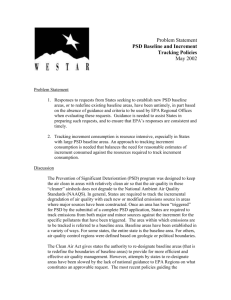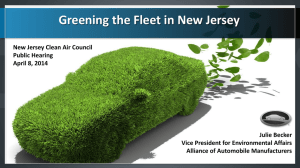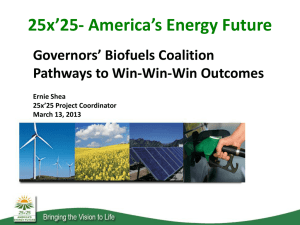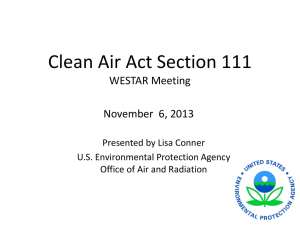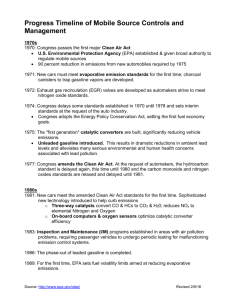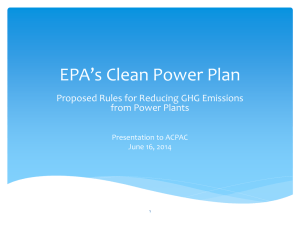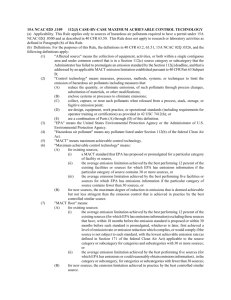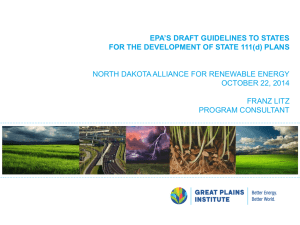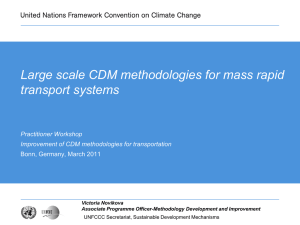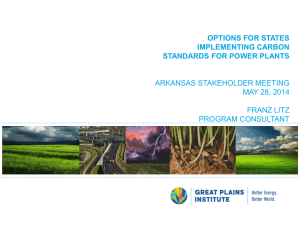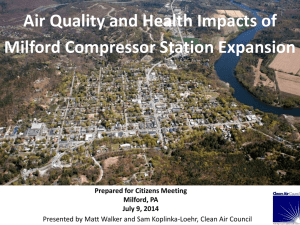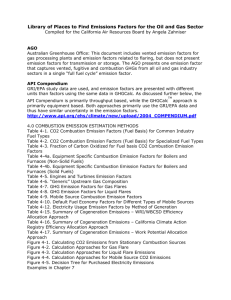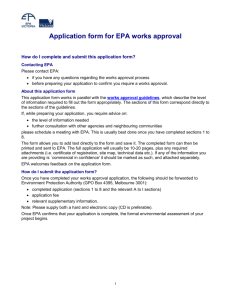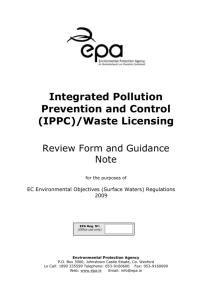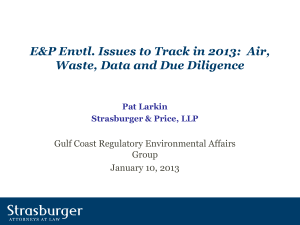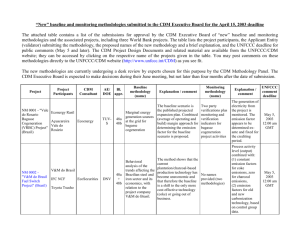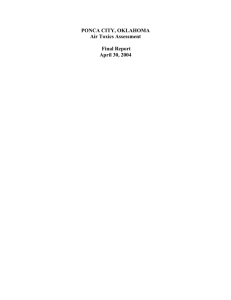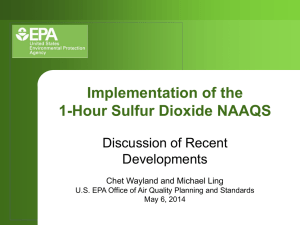(EE/RE) Policies & Programs - State/Local Air Pollution Control
advertisement
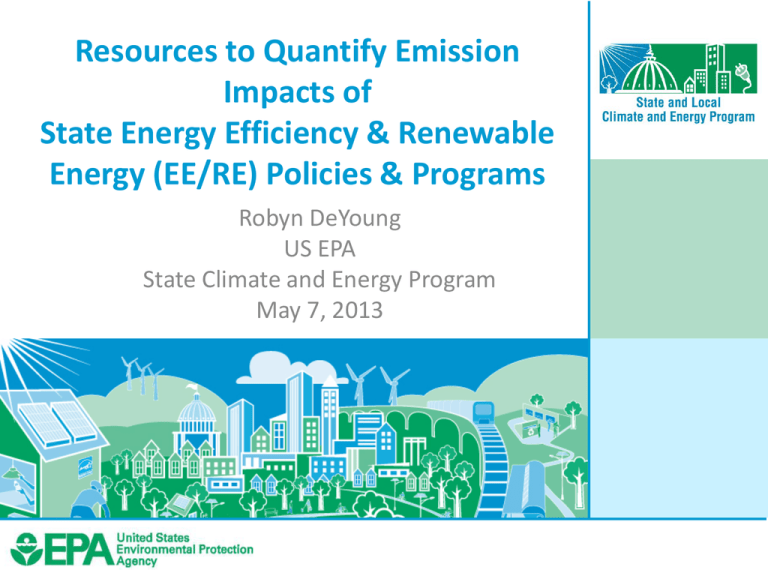
Resources to Quantify Emission Impacts of State Energy Efficiency & Renewable Energy (EE/RE) Policies & Programs Robyn DeYoung US EPA State Climate and Energy Program May 7, 2013 Today’s Briefing • Overview of working with states account for the benefits of EE/RE policies and programs • The opportunity for states • Roadmap for Incorporating EE/RE policies and Programs in SIPs • Analysis and resources to quantify emission benefits of EE/RE policies and programs – EPA analysis and approach for state EE policies – Quantification tools and resources 2 U.S. EPA’s State and Local Climate & Energy Program EPA’s State and Local Climate and Energy Program has built expertise and collaborative relationships with states for 15+ years Help States advance cost-effective emission reductions through EE/RE policies and programs Demonstrate ways to include EE/RE in air regulator’s compliance toolbox (Jointly with OAQPS and Regions) Develop resources and analyses that helps states link air/energy goals Advance training and pilots to further cross-agency collaboration, understanding and action (Jointly with OAQPS and Regions) • Energy/Air Workshop in Region 6 & NC (2012) • EE/RE Policy and AQ Training in VA (2012) • 3-State Pilot with MA, MD, NY (current) 3 State Clean Energy Actions Advance Air Quality Benefits • State air regulators looking for new ways to lower emissions, improve air quality Energy Efficiency Standards and Targets • Meanwhile, Public Utility Commissions and State Energy Offices are advancing proven EE/RE policies and programs EERS: 26 states – Implementing DOE programs, such as SEP and Weatherization – Ratepayer funding for EE was ~$7B in 2011 and is expected to rise to ~$9.5B by 2025 – Supportive utility regulations • Opportunity to capture costeffective emissions reductions Renewable & Alternative Energy Portfolio Standards RPS: 30 states 4 Source: Center for Climate and Energy Solutions, updated in July (EE) and October (RE) of 2012. Roadmap on Incorporating EE/RE in State Implementation Plans • Purpose: Navigate technical and policy barriers so states can account for emission benefits in SIPs • Clarify 2004 Guidance • Increase opportunities for using EE/RE • Cross-Agency OAR workgroup – Led by OAQPS, includes 7 regions • Provides four pathways states can use to account for emission benefits of EE/RE (Jointly with OAQPS) • • • • Baseline Emissions Projection Pathway Control Strategy Pathway Emerging/Voluntary measures Pathway Weight of evidence Pathway 5 Analysis and Resources to Quantify Emissions • Analysis and quantification resources – Baseline analysis and analytical steps to estimate existing EE policies for baseline emissions projections – Projected energy savings of existing state EE policies – Draft quantification tools (peer review complete) • Power Plant Emissions Calculator (P-PEC) – Employing the Capacity Factor Approach • AVoided Emissions and geneRation Tool (AVERT) – Employing the Hourly Emissions Rate Approach – Online training on electric energy system and quantifying EE/RE policies & programs 6 Baseline Analysis and Approach • Purpose – Recognize state leadership and action – Send a signal that accounting for on-the-books EE policies in baseline emissions forecasts is a viable SIP pathway – Demonstrate emission impacts of existing state EE policies • Lower electric demand and future baseline emissions means cost savings to attain the NAAQS – Describe an approach and steps that states can implement For more information visit: http://www.epa.gov/statelocalclimate/state/statepolicies.html 7 Baseline Analysis and Approach Analysis of projected emissions impacts of existing EE policies • Background – Recognized missed opportunities to reflect state policies not currently in EIA’s AEO 2010 projections and, hence, EPA’s baseline forecast • AEO accounts for some but not all EE/RE programs and policies – Established straightforward approach to capture EE policy impacts on energy saved (MWhs) • Existing EE policies represent 3% demand reduction – Provide emission projections of an illustrative EE baseline analysis 8 Estimating the Emission Benefits of EE/RE Policies and Programs Four Emission Quantification Approaches Approach Sophistication increases eGrid subregion nonbaseload approach Capacity factor approach Available Tools Power Plant Profiler and Portfolio Manager P-PEC (Draft) Reported Hourly emissions approach AVERT (in progress) Energy modeling approach IPM, Ventyx, MARKAL, NE-MARKAL, For more information visit: http://epa.gov/airquality/eere/pdfs/appendixI.pdf 9 Choosing a Quantification Approach • There are several key questions that can help narrow your options as you select an approach: – – – – • What is the purpose of the analysis? What types of emissions are you interested in? What scale do you care about? How much time and resources do you have? ? Match your answers to the approaches. Note: “?” indicates pending peer review 14 Key Considerations when quantifying EE/RE emission impacts • Understand baseline parameters to avoid double counting impacts • Work with energy regulators in states to get impacts for on-the-books EE/RE policies & programs • Focus on larger EE/RE policy impacts or bundle smaller EE/RE programs • Analysis should cover a region – similar to grid operations 11 Thank you For emissions quantification For the Roadmap and SIP related questions Robyn DeYoung U.S. EPA deyoung.robyn@epa.gov 202-343-9080 Angie Shatas U.S. EPA Shatas.angie@epa.gov 919-541-5454 Chris Stoneman U.S. EPA Stoneman.chris@epa.gov 919-541-0823 Additional Resources: Online training on electric sector http://www.epa.gov/apti/video/ElectricEnergy/ElectricEnergy0212.html Online module on quantifying emissions of EE/RE Policies http://www.epa.gov/apti/video/ElectricEnergy/Module%204%20%20Part%203/mod4pt3.swf 12

